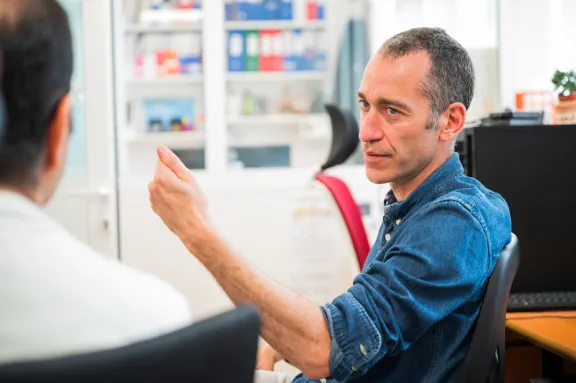Nicolas Minc Embryonic development: the cytoplasm has its say
Nicolas Minc, CNRS Research Director, head of the "Spatial Organization of the Cell" team at the Jacques Monod Institute in Paris
- 2020 • Bettencourt Prize Coups d'Élan pour la recherche française
- 2024 • Impulscience

What if cytoplasm is more interesting than it seems? Nicolas Minc and his team are preparing to test the physical properties of this fluid that fills all living cells, in order to understand how it influences processes such as cell division and embryonic development.
Cytoplasm, a fluid like no other
Cytoplasm is a complex fluid that fills all living cells. It can be imagined as a cluttered, viscous soup, made up of water, ions, different types of molecules, the network of filaments that make up the cell's skeleton, vesicles of varying size... These ingredients give the cytoplasm properties that are reminiscent of a soft gel and regulate many cellular functions. For example, the physical properties of the cytoplasm have an impact on the way in which small biological objects, such as proteins, move within the cell, thus affecting the speed at which certain biochemical reactions take place. However, the influence of cytoplasmic properties on the movement of large assemblies relevant to cell spatial organization and division, such as chromosomes or the nucleus, remains little studied.
The role of cytoplasm in cell division
Nicolas Minc uses innovative methods of imaging, mechanobiology and modelling, using the sea urchin embryo as a model, to study the physical properties of cytoplasm (viscosity, elasticity or fluidification) and understand how it flows within a cell.
Embryonic development is a complex and fascinating process, which begins with the division of a single cell to generate two identical cells, then 4, then 8, until it generates an embryo made up of a few hundred cells, and then an entire organism. This process requires the coordinated and precise movement of objects located in the cytoplasm, such as the various organelles (specialized structures separated from the rest of the cell by a membrane) and the cell skeleton.
Nicolas Minc's team recently demonstrated the role of the physical properties of the cytoplasm in the movement of the mitotic spindle, a system that ensures the correct distribution of chromosomes in cells during cell division. Currently, his team wants to address questions about how the physical properties of cytoplasm are controlled in space and time to regulate embryonic development.
Impulscience
The interdisciplinary project led by Nicolas Minc and supported by Impulscience is based on the early stages of development of sea urchin embryos, which have the advantage of having large cells with a vast cytoplasm. This model will enable Nicolas Minc's team to study the properties of the cytoplasm at several scales (from the single cell to the embryo), cellular states (dividing cells) and environments (pressures and temperatures).
Firstly, they want to understand how the composition of the cytoplasm defines its physical properties and enables it to adapt to variations in temperature and pressure specific to the marine environment. They will also assess the effects of internal objects, such as the cell skeleton and organelles, on the physical properties of the cytoplasm in order to promote cell division. Finally, they will study the importance of cytoplasmic properties for the early stages of embryonic development. This project will provide an unprecedented physical understanding of how the cytoplasm is controlled to regulate cell division and embryo formation.
Nicolas Minc in a few words
Nicolas Minc's dual background in physics and biology gives him an original perspective on fundamental biological problems, such as cell division. Nicolas Minc completed his PhD at the Institut Curie in Paris and joined the CNRS in 2011 after a post-doctoral stay at Columbia University in New York (United-States) between 2006 and 2010.
Since moving to the Institut Jacques Monod in 2013, his research projects have covered a wide range of cellular processes: he is developing precise force measurements to understand how organelles find their place in the cell, while exploiting quantitative imaging, genetics and physical modelling. He is also using numerical simulations to understand the early development of embryos.
He has received several awards, including the CNRS Bronze Medal in 2018 and the Bettencourt Prize Coups d'élan pour la recherche française from the Fondation Bettencourt Schueller in 2020.

Bettencourt Prize Coups d'Élan pour la recherche française
The Bettencourt Prize Coups d'Élan pour la recherche française was created by the Foundation in 2000. It has rewarded 78 French laboratories and more than 900 researchers have benefited from this prize. Until 2021, this prize was awarded each year to four research teams, from Inserm and the CNRS Institute of Biological Sciences. The amount of the prize endowment was 250,000 euros per laboratory.
All the award-winners



